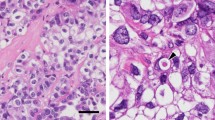Abstract
A new cell line of human ovarian clear cell adenocarcinoma (CCC), TU-OC-1, was established and characterized. The cells showed a polygonal-shaped morphology and grew in monolayers without contact inhibition and were arranged like a jigsaw puzzle. The chromosome numbers ranged from 64 to 90. A low rate of proliferation was observed, similar to other CCC cell lines tested (OVTOKO, RMG-I, and OVAS), and the doubling time was 38.4 h. The respective IC50 values of cisplatin and paclitaxel were 12.2 μM and 58.3 nM. Mutational analysis revealed that TU-OC-1 cells harbored a PIK3CA mutation at codon 542 (E542K) in exon 9, which is a mutation hot spot on this gene. We observed that phosphorylated Akt protein was overexpressed in TU-OC-1 cells by western blot analysis. Heterotransplantation to nude mice produced tumors that reflected the original. This cell line may be useful to study the chemoresistant mechanisms of CCC and contribute to novel treatment strategies.






Similar content being viewed by others
References
Scully RE. World Health Organization classification and nomenclature of ovarian cancer. Natl Cancer Inst Monogr. 1975;42:5–7.
Itamochi H, Kigawa J, Terakawa N. Mechanisms of chemoresistance and poor prognosis in ovarian clear cell carcinoma. Cancer Sci. 2008;99(4):653–8.
Aure JC, Hoeg K, Kolstad P. Mesonephroid tumors of the ovary. Clinical and histopathologic studies. Obstet Gynecol. 1971;37(6):860–7.
Sugiyama T, Kamura T, Kigawa J, et al. Clinical characteristics of clear cell carcinoma of the ovary: a distinct histologic type with poor prognosis and resistance to platinum-based chemotherapy. Cancer. 2000;88(11):2584–9.
Takano M, Kikuchi Y, Yaegashi N, et al. Clear cell carcinoma of the ovary: a retrospective multicentre experience of 254 patients with complete surgical staging. Br J Cancer. 2006;94(10):1369–74.
Vanhaesebroeck B, Alessi DR. The PI3K–PDK1 connection: more than just a road to PKB. Biochem J. 2000;346(Pt 3):561–76.
Vivanco I, Sawyers CL. The phosphatidylinositol 3-kinase AKT pathway in human cancer. Nat Rev Cancer. 2002;2(7):489–501.
van der Heijden MS, Bernards R. Inhibition of the PI3K pathway: hope we can believe in? Clin Cancer Res. 2010;16(12):3094–9.
Kuo KT, Mao TL, Jones S, et al. Frequent activating mutations of PIK3CA in ovarian clear cell carcinoma. Am J Pathol. 2009;174(5):1597–601.
Yamamoto S, Tsuda H, Takano M, Iwaya K, Tamai S, Matsubara O. PIK3CA mutation is an early event in the development of endometriosis-associated ovarian clear cell adenocarcinoma. J Pathol. 2011;225(2):189–94.
Li VS, Wong CW, Chan TL, et al. Mutations of PIK3CA in gastric adenocarcinoma. BMC Cancer. 2005;5:29.
Samuels Y, Diaz LA Jr, Schmidt-Kittler O, et al. Mutant PIK3CA promotes cell growth and invasion of human cancer cells. Cancer Cell. 2005;7(6):561–73.
Itamochi H, Kigawa J, Sugiyama T, Kikuchi Y, Suzuki M, Terakawa N. Low proliferation activity may be associated with chemoresistance in clear cell carcinoma of the ovary. Obstet Gynecol. 2002;100(2):281–7.
Itamochi H, Kigawa J, Akeshima R, et al. Mechanisms of cisplatin resistance in clear cell carcinoma of the ovary. Oncology. 2002;62(4):349–53.
Itamochi H, Yoshida T, Walker CL, et al. Novel mechanism of reduced proliferation in ovarian clear cell carcinoma cells: cytoplasmic sequestration of CDK2 by p27. Gynecol Oncol. 2011;122(3):641–7.
Dimanche-Boitrel MT, Pelletier H, Genne P, et al. Confluence-dependent resistance in human colon cancer cells: role of reduced drug accumulation and low intrinsic chemosensitivity of resting cells. Int J Cancer. 1992;50(5):677–82.
Barcellos-Hoff MH, Marton LJ, Deen DF. Differential drug sensitivity conferred by growth status detected in a mixed population of cycling and noncycling cells. Cancer Res. 1990;50(12):3551–5.
Agarwal R, Kaye SB. Ovarian cancer: strategies for overcoming resistance to chemotherapy. Nat Rev Cancer. 2003;3(7):502–16.
Itamochi H. Targeted therapies in epithelial ovarian cancer: molecular mechanisms of action. World J Biol Chem. 2010;1(7):209–20.
Samuels Y, Wang Z, Bardelli A, et al. High frequency of mutations of the PIK3CA gene in human cancers. Science. 2004;304(5670):554.
Bader AG, Kang S, Zhao L, Vogt PK. Oncogenic PI3K deregulates transcription and translation. Nat Rev Cancer. 2005;5(12):921–9.
Holmes D. PI3K pathway inhibitors approach junction. Nat Rev Drug Discov. 2011;10(8):563–4.
Wiegand KC, Shah SP, Al-Agha OM, et al. ARID1A mutations in endometriosis-associated ovarian carcinomas. N Engl J Med. 2010;363(16):1532–43.
McConechy MK, Anglesio MS, Kalloger SE, et al. Subtype-specific mutation of PPP2R1A in endometrial and ovarian carcinomas. J Pathol. 2011;223(5):567–73.
Shih IeM, Panuganti PK, Kuo KT, et al. Somatic mutations of PPP2R1A in ovarian and uterine carcinomas. Am J Pathol. 2011;178(4):1442–7.
Courtney KD, Corcoran RB, Engelman JA. The PI3K pathway as drug target in human cancer. J Clin Oncol. 2010;28(6):1075–83.
Acknowledgments
This work was supported by a Grant-in-Aid for Scientific Research from the Ministry of Education, Culture, Sports, Science and Technology of Japan (17244120 to H. Itamochi).
Conflict of interest
The authors delcare that they have no conflict of interest.
Author information
Authors and Affiliations
Corresponding author
Rights and permissions
About this article
Cite this article
Itamochi, H., Kato, M., Nishimura, M. et al. Establishment and characterization of a novel ovarian clear cell adenocarcinoma cell line, TU-OC-1, with a mutation in the PIK3CA gene. Human Cell 26, 121–127 (2013). https://doi.org/10.1007/s13577-013-0062-y
Received:
Accepted:
Published:
Issue Date:
DOI: https://doi.org/10.1007/s13577-013-0062-y




